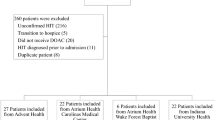Abstract
Background Patients with heparin-induced thrombocytopenia (HIT) require anticoagulation with alternative immediate acting anticoagulants such as lepirudin. Lepirudin may generate antibodies that increase risk of bleeding. Fondaparinux, on the other hand, is structurally too short to induce antibody formation, and therefore, it could be a useful agent for the treatment of HIT. Setting University teaching hospital in Saudi Arabia. Method A retrospective study was conducted at a university teaching hospital on HIT cases which were diagnosed between January 2006 and December 2009. The diagnosis was based on clinical findings consistent with HIT presentation (i.e., a confirmed fall in the platelet count to <100 × 109/L or a 50% reduction from baseline, four or more days after starting heparin therapy, with exclusion of other causes of thrombocytopenia) and a positive immunoassay test. Results Twelve HIT patients (6 males and 6 females) met the inclusion criteria. Fondaparinux was given to five subjects while lepirudin was utilized in seven patients. The median age was 65 years in the fondaparinux group, and 55 years in the lepirudin group. Nine patients (75%) were on heparin infusion, while three (25%) were on subcutaneous heparin or heparin flushes prior to HIT diagnosis. Frequencies of concomitant chronic diseases as well as other treatments including antiplatelets were similar between the two groups (P > 0.05). The time for platelets recovery was similar between the two groups (Median = 4 days for both arms; P = 0.736). Furthermore, fondaparinux therapy was associated with bigger area under platelet count compared to lepirudin (8,179 vs. 5,768 cell × 109*day/L; P = 0.0303), and higher nadir counts (89 vs. 44 cell × 109/L; P = 0.061). Conclusion The current study suggests that fondaparinux is a potential alternative treatment for HIT. Further larger studies are needed to confirm our findings.

Similar content being viewed by others
References
Fugate S, Chiappe J. Standardizing the management of heparin-induced thrombocytopenia. Am J Health Syst Pharm. 2008;65(4):334–9.
Martel N, Lee J, Wells PS. Risk for heparin-induced thrombocytopenia with unfractionated and low-molecular-weight heparin thromboprophylaxis: a meta-analysis. Blood. 2005;106(8):2710–5.
Greinacher A, Volpel H, Janssens U, Hach-Wunderle V, Kemkes-Matthes B, Eichler P, et al. Recombinant hirudin (lepirudin) provides safe and effective anticoagulation in patients with heparin-induced thrombocytopenia: a prospective study. Circulation. 1999;99(1):73–80.
Harenberg J, Jorg I, Fenyvesi T. Heparin-induced thrombocytopenia: pathophysiology and new treatment options. Pathophysiol Haemost Thromb. 2002;32(5–6):289–94.
Hirsh J, Heddle N, Kelton JG. Treatment of heparin-induced thrombocytopenia: a critical review. Arch Intern Med. 2004;164(4):361–9.
Hirsh J, Guyatt G, Albers GW, Harrington R, Schunemann HJ, American College of Chest Physician. Antithrombotic and thrombolytic therapy: American College of Chest Physicians evidence-based clinical practice guidelines (8th edition). Chest. 2008;133(6 Suppl):110S–2S.
Lee CJ, Ansell JE. Direct thrombin inhibitors. Br J Clin Pharmacol. 2011. doi:10.1111/j.1365-2125.2011.03916.x.
Jang IK, Hursting MJ. When heparins promote thrombosis: review of heparin-induced thrombocytopenia. Circulation. 2005;111(20):2671–83.
Lobo B, Finch C, Howard A, Minhas S. Fondaparinux for the treatment of patients with acute heparin-induced thrombocytopenia. Thromb Haemost. 2008;99(1):208–14.
Kovacs MJ. Successful treatment of heparin induced thrombocytopenia (HIT) with fondaparinux. Thromb Haemost. 2005;93(5):999–1000.
Spyropoulos AC, Magnuson S, Koh SK. The use of fondaparinux for the treatment of venous thromboembolism in a patient with heparin-induced thombocytopenia and thrombosis caused by heparin flushes. Ther Clin Risk Manag. 2008;4(3):653–7.
Warkentin TE, Maurer BT, Aster RH. Heparin-induced thrombocytopenia associated with fondaparinux. N Engl J Med. 2007;356(25):2653–5. discussion 2653–5.
Parody R, Oliver A, Souto JC, Fontcuberta J. Fondaparinux (ARIXTRA) as an alternative anti-thrombotic prophylaxis when there is hypersensitivity to low molecular weight and unfractionated heparins. Haematologica. 2003;88(11):ECR32.
Blackmer AB, Oertel MD, Valgus JM. Fondaparinux and the management of heparin-induced thrombocytopenia: the journey continues. Ann Pharmacother. 2009;43(10):1636–46.
Warkentin TE. Heparin-induced thrombocytopenia: diagnosis and management. Circulation. 2004;110(18):e454–8.
Grouzi E, Kyriakou E, Panagou I, Spiliotopoulou I. Fondaparinux for the treatment of acute heparin-induced thrombocytopenia: a single-center experience. Clin Appl Thromb Hemost. 2010;16(6):663–7.
Bradner J, Hallisey RK, Kuter DJ. Fondaparinux in the treatment of heparin-induced thrombocytopenia (abstract). Blood. 2004;104:492a.
Stratmann G, deSilva AM, Tseng EE, Hambleton J, Balea M, Romo AJ, et al. Reversal of direct thrombin inhibition after cardiopulmonary bypass in a patient with heparin-induced thrombocytopenia. Anesth Analg. 2004;98(6):1635–9.
Acknowledgments
Authors would like to thank the pharmacy, medical records and laboratory staff at King Khalid University Hospital, Riyadh, Saudi Arabia, for facilitating the conduction of the study.
Funding
No funds to be declared.
Conflicts of interest
No conflicts to be declared.
Author information
Authors and Affiliations
Corresponding author
Rights and permissions
About this article
Cite this article
Al-Rossaies, A., Alkharfy, K.M., Al-Ayoubi, F. et al. Heparin-induced thrombocytopenia: comparison between response to fondaparinux and lepirudin. Int J Clin Pharm 33, 997–1001 (2011). https://doi.org/10.1007/s11096-011-9573-3
Received:
Accepted:
Published:
Issue Date:
DOI: https://doi.org/10.1007/s11096-011-9573-3




